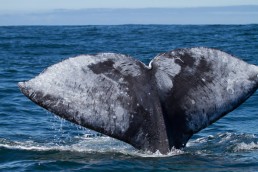Gray Whale Senses
Gray Whale Senses
Hearing: Hearing is the most important sense for whales. Sound travels four times as fast as it does in air and travels further. Some of the sound’s whales make can be heard above water. Fishermen used to think that their moans and whistles were sea monsters or mermaids. They vocalize using clicks, groans, grunts, and squeaks. These sounds are produced by squeezing air through the blowhole or by bursts of air from the lungs.
Sight: Since their eyes are far back on their head, their vision consists of two fields on either side of the body. There is some uncertainty about how well whales can see because their eyes are small, (about the size of an orange). It is unknown whether whales can see colors or not. Gray whales have good eyesight. When near the shoreline or boats, gray whales will sometimes rise vertically out of the water. They do this to scan its surroundings, this behavior is called spyhopping.
Food: Gray whales are mostly bottom feeders. 90% of them are right sided feeders. They expand and contract their throat grooves and retract their tongue which creates suction that brings mud into its mouth. The mud is moved around and pushed out through the baleen. The food gets trapped by the baleen and the rest is pushed out the sides of the mouth.
Baleen whales do not have teeth, instead they have 130 to 180 baleen plates that hang down each side of their upper jaws, like a fringy curtain. The plates are made of fingernail like material called keratin. It makes the baleen strong, and flexible. On the throat, the gray whale has two to seven grooves. These grooves expand and contract, allowing the whale to swallow mouthfuls of food and water when feeding.
Diseases: Whales can get cancers, stomach ulcers, heart disease, pneumonia, jaundice, and arthritis. Sometimes whales are found stranded on beaches, possibly from illness, wave action, currents, or parasitic diseases which affect the whale’s ability to navigate.
Ears: The whale has no sense of smell, the outer ears, which in land mammals help collect the sound. The ear openings are only the size of a pencil point. Water, unlike air, is a particularly good medium for carrying sound and this might explain the small ears. It also might be the reason for other methods of communication such as breaching, or sounds made within the throat.

